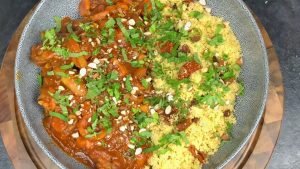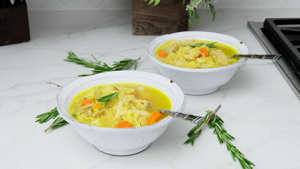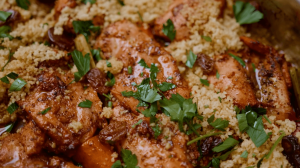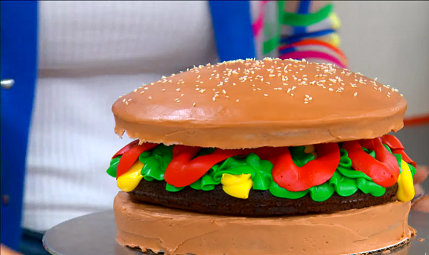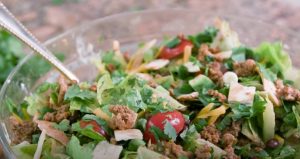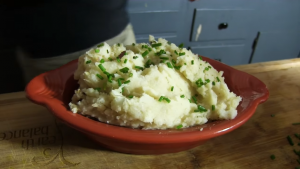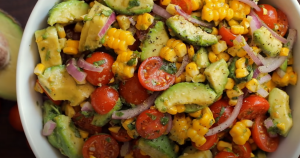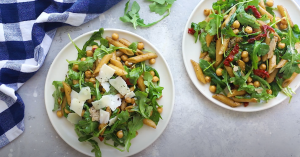Moroccan couscous with roasted vegetables is a delightful dish that combines the rich flavors of the Mediterranean with the hearty wholesomeness of roasted vegetables. This plate is not only pleasing to the palate but also nourishing, offering a good balance of grains, veggies, and spices.
Most ingredients for this recipe should be readily available in your local supermarket. However, if you can't find couscous, it's usually located in the rice or international foods aisle. Turmeric, cumin, coriander, and cinnamon are essential spices for this dish and can usually be found in the spices section. If chickpeas are not commonly found at home, you can find them either canned or dried in the legume section.
Ingredients for Moroccan Couscous with Roasted Vegetables
Red bell pepper: Adds a sweet, slightly bitter taste and a vibrant red color to the dish.
Carrots: They bring a sweet, earthy flavor and add beautiful color to the dish.
Red onion: Brings a sharp, astringent yet sweet flavor.
Zucchini: Adds a mild flavor and a nice, soft texture when roasted.
Olive oil: Used for roasting the vegetables and for the dressing. Its fruity, rich flavor enhances the dish.
Lemon juice: Adds a tangy freshness that balances the rich flavors of the dish.
Garlic: Brings a spicy, pungent flavor that complements the other ingredients.
Ground cumin, coriander, and cinnamon: These spices are essential for the Moroccan flavor profile, adding warmth and depth to the dish.
Couscous: A staple in North African cuisine, it's light, fluffy, and serves as the base of the dish.
Chicken broth: Used to cook the couscous, it brings a savory, umami flavor.
Turmeric: Gives the couscous a vibrant yellow color and a subtle earthy flavor.
Raisins: Add a sweet contrast to the savory ingredients.
Chickpeas: They provide protein and a satisfying, hearty texture.
Slivered almonds: Add crunch and a delicate, nutty taste.
Fresh cilantro and mint: These herbs add brightness and freshness to the dish.
One reader, Annette Fain says:





This Moroccan couscous with roasted vegetables recipe is a game-changer! The blend of spices and the roasted veggies create a burst of flavors. It's a healthy and satisfying dish that's perfect for a cozy dinner. The combination of textures and the aromatic herbs make it a delightful experience. Highly recommended!
Techniques Required
How to roast vegetables: Preheat the oven to 475 degrees F and spray a rimmed baking sheet with non-stick cooking spray. Place the prepared vegetables on the baking sheet, drizzle with olive oil, season with salt, and roast for about 15 minutes until tender, tossing once halfway through roasting. If desired, move the oven rack closer to the broiler and broil for 1 to 2 minutes to add a light char.
How to prepare couscous: Bring chicken broth, salt, and turmeric to a boil. Place couscous and raisins in a large mixing bowl, pour hot chicken broth over couscous, and stir. Cover the bowl with plastic wrap and let it rest for 5 minutes.
How to make the lemon dressing: In a small mixing bowl, whisk together olive oil, lemon juice, garlic, cumin, coriander, cinnamon, and salt. Set aside.
How to assemble the dish: Add the roasted vegetables, chickpeas, almonds, cilantro, mint, and lemon dressing to the couscous and toss to evenly coat. Season with a little more salt to taste as desired. Serve warm.
How To Make Moroccan Couscous with Roasted Vegetables
Taste the flavors of this Moroccan couscous tossed with roasted broccoli, zucchini, and bell peppers, coated with spiced lemon juice blend.
Serves:
Ingredients
- 1large red bell pepper,cored and diced
- 2medium carrots,halved through length and sliced fairly thin
- 1small red onion,diced into 1-inch chunks
- 1medium zucchini,halved through the length and sliced
- 4tbspolive oil,divided
- 2tbspfresh lemon juice
- 2tspgarlic,minced
- 1tspground cumin
- 1tspground coriander
- ½tspground cinnamon
- salt
- 1⅓cupsdry couscous
- 14.5ozlow-sodium chicken broth,(1 can)
- ½tspturmeric
- ½cupraisins
- 14ozchick peas,(1 can), drained and rinsed
- ½cupslivered almonds,toasted
- 3tbspfresh cilantro,minced
- 2tbspfresh mint,minced
Instructions
-
Preheat oven to 475 degrees F. Spray an 18×13-inch rimmed baking sheet with non-stick cooking spray.
-
Place bell pepper, carrots, onions, and zucchini on the baking sheet. Drizzle with 1 tablespoon of olive oil and season with salt and toss to evenly coat.
-
Roast in preheated oven for about 15 minutes until tender, tossing once halfway through roasting.
-
Then if desired move the oven rack closer to the broiler and broil for about 1 to 2 minutes to add a light char.
-
While vegetables are roasting, in a small mixing bowl whisk together the remaining 3 tablespoons of olive oil, lemon juice, garlic, cumin, coriander, cinnamon, and season with ¼ teaspoon salt, set aside.
-
Bring chicken broth, ½ teaspoon salt, and turmeric to a boil. Place couscous and raisins in a large mixing bowl, pour hot chicken broth over couscous, and stir. Cover bowl with plastic wrap and let rest for 5 minutes.
-
Add roasted vegetables, chickpeas, almonds, cilantro, mint, and lemon mixture to couscous and toss to evenly coat. Season with a little more salt to taste as desired. Serve warm.
Nutrition
- Calories: 352.20kcal
- Fat: 12.77g
- Saturated Fat: 1.61g
- Trans Fat: 0.00g
- Monounsaturated Fat: 8.37g
- Polyunsaturated Fat: 2.12g
- Carbohydrates: 50.45g
- Fiber: 7.76g
- Sugar: 12.83g
- Protein: 11.49g
- Sodium: 607.39mg
- Calcium: 77.04mg
- Potassium: 602.02mg
- Iron: 2.71mg
- Vitamin A: 211.63µg
- Vitamin C: 61.97mg
Technique Tip for Perfectly Cooked Couscous
To ensure your couscous is fluffy and not clumpy, make sure to fluff it with a fork after it has absorbed the chicken broth. This will separate the grains and give your couscous a light, airy texture. Additionally, when roasting your vegetables, try to cut them into similar sizes. This ensures even cooking and prevents smaller pieces from burning while larger pieces are still undercooked.
Time-Saving Tips for Preparing Moroccan Couscous
Prep ahead: Chop and prepare all the vegetables and ingredients the night before to save time on the day of cooking.
Use pre-cut vegetables: Consider using pre-cut vegetables from the store to cut down on prep time.
Multi-task: While the vegetables are roasting, use that time to prepare the couscous and other ingredients to maximize efficiency.
One-pot cooking: Consider using a large pot or pan to cook the vegetables and couscous together to save on clean-up time.
Invest in a good knife: A sharp, high-quality knife can make chopping and prepping vegetables much quicker and easier.
Substitute Ingredients For Moroccan Couscous with Roasted Vegetables Recipe
couscous - Substitute with quinoa: Quinoa is a great substitute for couscous as it has a similar texture and can absorb the flavors of the dish. It also provides a higher protein content and is gluten-free, making it a versatile and nutritious alternative.
chicken broth - Substitute with vegetable broth: Vegetable broth can be used as a substitute for chicken broth to make the dish vegetarian-friendly. It also adds a rich flavor to the couscous and roasted vegetables.
chick peas - Substitute with white beans: White beans can be used as a substitute for chickpeas to add a creamy texture and mild flavor to the dish. They also provide a good source of protein and fiber.
slivered almonds - Substitute with pine nuts: Pine nuts can be used as a substitute for slivered almonds to add a nutty flavor and crunchy texture to the dish. They complement the Moroccan flavors and roasted vegetables well.
fresh cilantro - Substitute with fresh parsley: Fresh parsley can be used as a substitute for cilantro to add a fresh and herbaceous flavor to the dish. It is a versatile herb that pairs well with the roasted vegetables and couscous.
fresh mint - Substitute with fresh basil: Fresh basil can be used as a substitute for mint to add a fragrant and aromatic flavor to the dish. It complements the Moroccan spices and roasted vegetables beautifully.
Plating Ideas for a Stunning Presentation
Elevate the plating: When presenting the Moroccan couscous with roasted vegetables, focus on creating a visually stunning plate. Use colorful and vibrant vegetables to add visual appeal. Arrange the couscous and vegetables in an artful manner, creating a feast for the eyes as well as the palate.
Incorporate texture: Add a variety of textures to the dish to enhance the dining experience. Consider incorporating crunchy slivered almonds and tender roasted vegetables to create a delightful contrast in each bite.
Utilize fresh herbs: Garnish the dish with an assortment of fresh cilantro and mint to infuse a burst of freshness and aroma. The vibrant green hues of the herbs will add a pop of color to the presentation.
Balance flavors: Ensure that the flavors are well-balanced and harmonious. The sweetness of the raisins should complement the savory elements, while the spices should be delicately balanced to create a memorable taste experience.
Attention to detail: Pay close attention to the finer details of the presentation. Wipe the edges of the plate to ensure a clean presentation, and consider using tweezers to delicately place the garnishes for a polished finish.
Harmonize colors: Create a visually appealing plate by considering the color composition. The vibrant hues of the roasted vegetables should be strategically placed alongside the golden couscous to create an aesthetically pleasing arrangement.
Emphasize the star ingredients: Highlight the star ingredients, such as the roasted vegetables and chickpeas, by placing them at the forefront of the dish. This draws attention to the key components of the recipe.
Artistic drizzling: Consider incorporating an artistic drizzle of olive oil or a squeeze of fresh lemon juice to add a touch of elegance to the presentation, elevating the overall visual appeal of the dish.
How To Store / Freeze Moroccan Couscous with Roasted Vegetables
Allow the moroccan couscous with roasted vegetables to cool completely before storing. This will prevent the couscous from becoming mushy and the vegetables from losing their texture.
Transfer the cooled couscous and roasted vegetables to an airtight container. Make sure the container is large enough to accommodate the entire dish without crushing the ingredients.
If you have any leftover lemon mixture or dressing, store it separately in a small airtight container. This will allow you to add it to the couscous just before serving, ensuring the flavors remain fresh and vibrant.
Place the airtight container(s) in the refrigerator. The moroccan couscous with roasted vegetables will keep well for up to 3-4 days when stored properly.
If you want to freeze the dish for later consumption, follow these steps:
- Divide the cooled couscous and roasted vegetables into portion-sized freezer-safe containers or resealable bags.
- Squeeze out any excess air from the bags before sealing them tightly. This will help prevent freezer burn and maintain the quality of the dish.
- Label the containers or bags with the date and contents for easy identification.
- Place the containers or bags in the freezer. The moroccan couscous with roasted vegetables can be frozen for up to 2-3 months.
To reheat the frozen couscous and vegetables, follow these methods:
- Microwave: Transfer the desired portion to a microwave-safe dish, cover it with a damp paper towel, and microwave on high for 2-3 minutes, stirring halfway through, until heated through.
- Stovetop: Place the desired portion in a saucepan over medium heat. Add a splash of water or chicken broth to help rehydrate the couscous and prevent it from sticking. Stir occasionally until heated through, about 5-7 minutes.
If you stored the lemon mixture or dressing separately, add it to the reheated couscous and vegetables just before serving. Stir well to combine and distribute the flavors evenly.
Garnish the reheated dish with fresh cilantro, mint, or a sprinkle of slivered almonds for added freshness and crunch.
How To Reheat Leftovers
To reheat leftover moroccan couscous with roasted vegetables, start by placing the desired amount in a microwave-safe bowl. Cover the bowl with a damp paper towel or a microwave-safe lid, leaving a small gap for steam to escape. Microwave on high for 1-2 minutes, stirring halfway through, until the couscous is heated through and steaming.
For a stovetop method, place the leftover couscous in a saucepan with a splash of chicken broth or water. Cover the pan and heat over medium-low heat, stirring occasionally, until the couscous is heated through and the liquid is absorbed, about 5-7 minutes. If the couscous seems dry, add a bit more liquid as needed.
To reheat in the oven, preheat the oven to 350°F (175°C). Transfer the leftover moroccan couscous with roasted vegetables to an oven-safe dish and cover with foil. Bake for 15-20 minutes, or until the couscous is heated through. Remove the foil for the last 5 minutes of reheating to allow any excess moisture to evaporate and the top to crisp up slightly.
If you have a bit more time, consider reheating the roasted vegetables separately from the couscous. Spread the vegetables on a baking sheet and reheat in a preheated 400°F (200°C) oven for 5-10 minutes, or until they are heated through and slightly crispy. Meanwhile, reheat the couscous using one of the methods mentioned above, then combine the two components before serving.
For a quick and easy lunch, transform leftover moroccan couscous with roasted vegetables into a cold salad. Simply fluff the couscous with a fork and toss it with the roasted vegetables. Add a squeeze of fresh lemon juice, a drizzle of olive oil, and some chopped fresh herbs like cilantro or mint. This refreshing, cold salad is perfect for a light lunch or as a side dish.
Random Fact about Moroccan Couscous with Roasted Vegetables
The Moroccan couscous with roasted vegetables recipe is a delicious and nutritious dish that combines a variety of flavors and textures. It's a great source of plant-based protein, fiber, and essential vitamins and minerals. This dish is also versatile and can be customized with different vegetables and spices to suit your taste preferences. Enjoying this meal can be a wonderful way to explore the rich culinary heritage of Moroccan cuisine.
Is This Recipe Budget-Friendly for Home Cooking?
The cost-effectiveness of this Moroccan couscous with roasted vegetables recipe is quite high. The main ingredients, such as vegetables, couscous, and chickpeas, are affordable and readily available. The addition of raisins and slivered almonds may slightly increase the cost, but they contribute to the dish's flavor and nutritional value. Overall, this recipe offers a balanced combination of cost-effectiveness and nutritional benefits. Rating: 9/10. The approximate cost for a household of 4 people is around $15-$20, making it a budget-friendly and satisfying meal option.
Is Moroccan Couscous with Roasted Vegetables Healthy?
The Moroccan couscous with roasted vegetables recipe is a healthy and nutritious dish overall. Here's why:
- The recipe is packed with a variety of colorful vegetables, including bell peppers, carrots, onions, and zucchini, which provide essential vitamins, minerals, and fiber.
- Couscous, a staple in North African cuisine, is a good source of complex carbohydrates and protein.
- The use of olive oil, a healthy fat, helps absorb fat-soluble vitamins and promotes heart health.
- The addition of chickpeas provides an excellent source of plant-based protein and fiber, which can help maintain a feeling of fullness and aid in digestion.
- The spices used, such as cumin, coriander, cinnamon, and turmeric, not only add flavor but also have anti-inflammatory properties and potential health benefits.
- The recipe uses low-sodium chicken broth, which helps control sodium intake.
To make this recipe even healthier, consider the following suggestions:
- Increase the proportion of vegetables to couscous to boost the nutrient density of the dish.
- Opt for whole wheat couscous to increase the fiber content and provide additional nutrients.
- Reduce the amount of oil used in the dressing or replace some of it with a low-fat alternative like yogurt or tahini.
- Include a lean protein source, such as grilled chicken or shrimp, to make the dish more balanced and satisfying.
- Experiment with adding other nutrient-dense ingredients, such as spinach, kale, or sweet potatoes, to further enhance the nutritional value of the recipe.
Editor's Thoughts on This Delightful Moroccan Dish
This Moroccan couscous with roasted vegetables recipe is a delightful combination of flavors and textures. The roasted vegetables bring a smoky sweetness, while the couscous provides a light and fluffy base. The blend of spices adds depth and warmth, and the raisins provide a touch of sweetness. The chickpeas and almonds contribute a satisfying crunch, and the fresh herbs bring a burst of freshness. Overall, this dish is a harmonious blend of savory, sweet, and aromatic elements that will surely impress your guests and elevate any meal.
Enhance Your Moroccan Couscous with Roasted Vegetables Recipe with These Unique Side Dishes:
Similar Recipes to Try If You Love This Dish
Appetizer and Dessert Pairings for a Moroccan-Themed Meal
Why trust this Moroccan Couscous with Roasted Vegetables Recipe:
This Moroccan couscous recipe offers a tantalizing fusion of flavors and textures. The roasted vegetables bring a delightful charred sweetness, while the aromatic blend of cumin, coriander, and cinnamon infuses the dish with rich, warm undertones. The addition of raisins provides a burst of sweetness, perfectly complementing the nutty crunch of slivered almonds. With the wholesome goodness of chickpeas and the refreshing notes of fresh cilantro and mint, this recipe promises a harmonious symphony of Mediterranean flavors that will surely delight the senses.
Was this page helpful?
Have your own special recipe to share? Submit Your Recipe Today!


